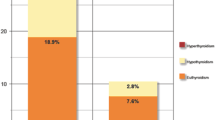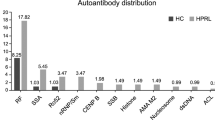Abstract
Recent studies have shown that hormones could induce anti-parasitic functions of the host immune system; thus, the aim of the present study was to estimate the seroprevalence of Toxoplasma gondii antibodies by an enzyme-linked immunosorbent assay in a Polish population of women and men with hyperprolactinaemia (n = 234) and hypoprolactinaemia (n = 41) and in a control group (n = 281) with the physiological level of prolactin (PRL). Women with hyperprolactinaemia revealed lower seroprevalence than those with normal PRL level (33.90% and 45.58%, respectively; p = 0.025). Detailed analysis of the results showed that twofold, threefold, fourfold and fivefold increase of the PRL concentration above the normal was correlated to the decrease of the T. gondii seroprevalence, but only in the group of women with a very high PRL level (>86 ng/ml) seroprevalence (12.50%) was significantly lower (p = 0.0004) than in the control subjects. These results confirm previously described suggestions on the relationship between hyperprolactinaemia and parasitic infection frequency. We postulate that a high level of PRL may be one of the important factors preventing T. gondii infection in women.


Similar content being viewed by others
References
Acuna-Soto R, Maguire JH, Wirth DF (2000) Gender distribution in asymptomatic and invasive amebiasis. Am J Gastroenterol 95:1277–1283
Anisman H, Baines MG, Berczi I, Bernstein CN, Blennerhassett MG, Gorczynski RM, Greenberg AH, Kisil FT, Mathison RD, Nagy E, Nance DM, Perdue MH, Pomerantz DK, Sabbadini ER, Stanisz A, Warrington RJ (1996) Neuroimmune mechanisms in health and disease: 1. Health. Can Med Assoc J 155:867–874
Ben-Jonathan N, Mershon JL, Allen DL, Steinmetz RW (1996) Extrapituitary prolactin: distribution, regulation, functions, and clinical aspects. Endocr Rev 17:639–669
Benedetto N, Auriault C (2002) Prolactin–cytokine network in the defence against Acanthamoeba castellanii in murine microglia. Eur Cytokine Netw 13:447–455
Benedetto N, Folgore A, Galdiero M, Meli R, Di Carlo R (1995) Effect of prolactin, rIFN-gamma or rTNF-alpha in murine toxoplasmosis. Pathol Biol (Paris) 43:395–400
Benedetto N, Folgore A, Romano-Carratelli C, Galdiero F (2001) Effects of cytokines and prolactin on the replication of Toxoplasma gondii in murine microglia. Eur Cytokine Netw 12:348–358
Berczi I (1994) The role of growth and lactogenic hormone family in immune function. Neuroimmunomodulation 1:201–216
Beverley JKA, Fleck DG, Kwantes W, Ludlam GB (1976) Age sex distribution of various diseases with particular reference to toxoplasmic lymphadenopathy. J Hyg 76:215–228
Bole-Feysot C, Goffin V, Edery M, Binart N, Kelly PA (1998) Prolactin (PRL) and its receptors: actions, signal transduction pathways and phenotypes observed in the PRL receptor knockout mice. Endocr Rev 19:225–268
Brown RR, Elston TH, Evans L, Glaser C, Gulledge ML, Jarboe L, Lappin MR, Marcus LC, American Association of Feline Practitioners (2005) Feline zoonoses guidelines from the American Association of Feline Practitioners. Journal of Feline Medicine & Surgery 7:243–274
Dubey JP (1998) Advances in the life cycle of Toxoplasma gondii. Int J Parasitol 28:1019–1024
Dubey JP, Lindsay DS, Speer CA (1998) Structures of Toxoplasma gondii tachyzoites, bradyzoites, and sporozoites and biology and development of tissue cysts. Clin Microbiol Rev 11:267–299
Gala RR (1991) Prolactin and growth hormone in the regulation of the immune system. Proc Soc Exp Biol Med 198:513–527
Gerlo S, Verdood P, Hooghe-Peters EL, Kooijman R (2005) Modulation of prolactin expression in humans T lymphocytes by cytokines. J Neuroimmunol 162:190–193
Goble FC, Konopka EA (1973) Sex as a factor in infectious disease. Trans N Y Acad Sci 35:325–346
Gomez-Ochoa P, Gascon FM, Lucientes J, Larraga V, Castillo JA (2003) Lactating females Syrian hamster (Mesocricetus auratus) show protection against experimental Leishmania infantum infection. Vet Parasitol 11:61–64
Ibars CB, Rodriguez AB, Skwarlo-Sonta K, Lea RW (1997) Mitogenic effect of naturally occurring elevated plasma prolactin on ring dove lymphocytes. Dev Comp Immunol 21:47–58
Jeske W (1979) The effect of metoclopramide, TRH and L-dopa on prolactin secretion in pituitary adenoma and in “functional” galactorrhoea syndrome. Acta Endocrinol (Copenh) 91(3):385–396
Jones TC, Johnson WD, Barretto AC, Lago E, Badaro R, Cerf B, Reed SG, Netto EM, Tada MS, Franca TF et al (1987) Epidemiology of American cutaneous leishmaniasis due to Leishmania braziliensis braziliensis. J Infect Dis 156:73–83
Kelly PA, Djiane J, Postel-Vinay MC, Edery M (1991) The prolactin/growth hormone receptor family. Endocr Rev 12:235–251
Khalifa AM, Ibrahim IR, el-Kerdany ED (2000) Coccidial infection in immunosuppressed mice: prophylaxis and treatment with dehydroepiandrosterone. East Mediterr Health J 6:908–918
Klein SL (2004) Hormonal and immunological mechanisms mediating sex differences in parasite infection. Parasite Immunol 26:247–264
Kodjikian L, Wallon M, Fleury J, Denis P, Binquet C, Peyron F, Garweg JG (2006) Ocular manifestations in congenital toxoplasmosis. Graefe Arch Clin Exp Ophthalmol 244:14–21
Langraft B, Kollaritsch H, Wiedermann G, Wernsdorfer WH (1994) Parasite density of Plasmodium farciparum malaria in Ghanaian schoolchildren: evidence of influence of sex hormones. Trans R Soc Trop Med Hyg 88:73–74
Leenstra T, ter Kuile FO, Kariuki SK, Nixon CP, Oloo AJ, Kager PA, Kurtis JD (2003) Dehydroepiandrosterone sulfate levels associated with decreased malaria parasite density and increased hemoglobin concentration in pubertal girls from western Kenya. J Infect Dis 188:297–304
Matera L, Muccioli G, Cesano A, Bellussi G, Genazzani E (1988) Prolactin receptors on large granular lymphocytes: dual regulation by cyclosporine A. Brain Behav Immun 2:1–10
McFadden DC, Camps M, Boothroyd JC (2001) Resistance as a tool in the study of old and a new drug targets in Toxoplasma. Drug Resist Updat 4:79–84
Meli R, Bentivoglio C, Nuzzo I, Mattace Raso G, Galdiero E, Galdiero M, Di Carlo R, Carratelli CR (2003) Th1–Th2 response in hyperprolactinemic mice infected with Salmonella enterica serovar Typhimurium. Eur Cytokine Netw 14:186–191
Oberbeck R, Schmitz D, Wilsenack K, Schüler M, Biskup C, Schedlowski M, Nast-Kolb D, Exton MS (2003) Prolactin modulates survival and cellular immune functions in septic mice. J Surg Res 113:248–256
Oktenil C, Doganci L, Ozgurtas T, Araz RE, Tanyuksel M, Musabak U, Sanisoglu SY, Yesilova Z, Erbil MK, Inal A (2004) Transient hypogonadotrophic hypogonadism in males with acute toxoplasmosis: suppressive effect of interleukin-1β on the secretion of GnRH. Hum Reprod 19:859–866
Ortega E, Forner MA, Barriga C (1996) Effect of prolactin on the in vitro phagocytic capacity of macrophages. Comp Immunol Microbiol Infect Dis 19:139–146
Reichmann G, Długońska H, Hiszczyńska-Sawicka E, Fischer H (2001) Tachyzoite-specific isoform of Toxoplasma gondii lactate dehydrogenase is the target antigen of a murine CD4(+) T-cell clone. Microbes Infect 3:779–87
Roberts CW, Walker W, Alexander J (2001) Sex-associated hormones and immunity to protozoan parasites. Clin Microbiol Rev 14:476–488
Robinson RO, Baumann RJ (1980) Late cerebral relapse of congenital toxoplasmosis. Arch Dis Child 55:231–232
Russell DH, Matrisian L, Kibler R, Larson DF, Poulos B, Magun BE (1984) Prolactin receptors on human lymphocytes and their modulation by cyclosporine. Biochem Biophys Res Commun 29:899–906
Setian N, Andrade RS, Kuperman H, Manna TD, Dichtchekenian V, Damiani D (2002) Precocious puberty: an endocrine manifestation in congenital toxoplasmosis. J Pediatr Endocrinol Metab 15:1487–1490
Skwarlo-Sonta K (1992) Prolactin as an immunoregulatory hormone in mammals and birds. Immunol Lett 33:105–121
Sroka J (2001) Seroepidemiology of toxoplasmosis in the Lublin region. Ann Agric Environ Med 8:25–31
Sun R, Li AL, Wei HM, Tian ZG (2004) Expression of prolactin receptors and response to prolactin stimulation of human NK cell lines. Cell Res 14:67–73
Tenter AM, Heckeroth AR, Weiss LM (2000) Toxoplasma gondii: from animals to humans. Int J Parasitol 30:1217–1258
Zhang X, Li Q, Hu P, Cheng H, Huang G (2002) Two case reports of pituitary adenoma associated with Toxoplasma gondii infection. J Clin Pathol 55:965–966
Author information
Authors and Affiliations
Corresponding author
Rights and permissions
About this article
Cite this article
Dzitko, K., Malicki, S. & Komorowski, J. Effect of hyperprolactinaemia on Toxoplasma gondii prevalence in humans. Parasitol Res 102, 723–729 (2008). https://doi.org/10.1007/s00436-007-0824-0
Received:
Accepted:
Published:
Issue Date:
DOI: https://doi.org/10.1007/s00436-007-0824-0




